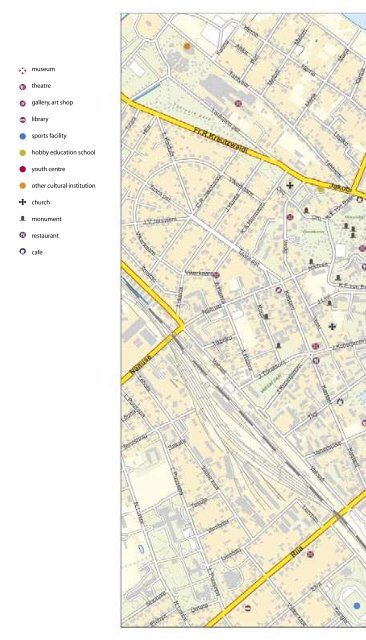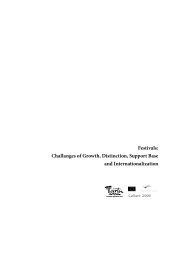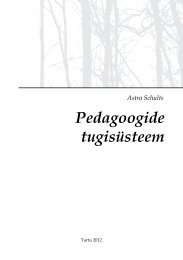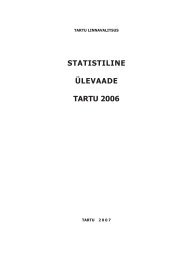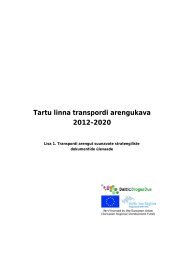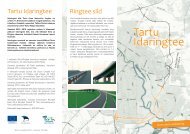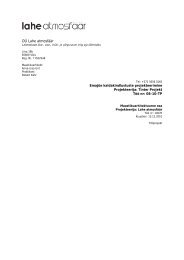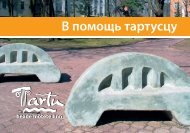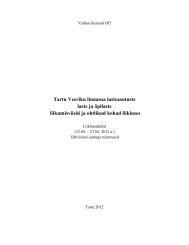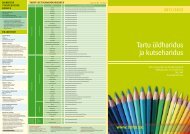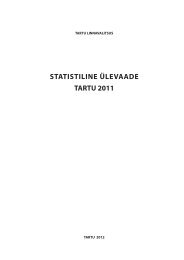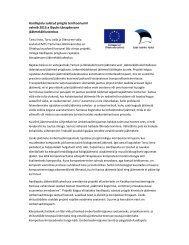Tartu's cultural institutions and organisations
Tartu's cultural institutions and organisations
Tartu's cultural institutions and organisations
Create successful ePaper yourself
Turn your PDF publications into a flip-book with our unique Google optimized e-Paper software.
16 17<br />
Tartu University Museums<br />
Tartu University Art Museum<br />
Mon-Fri 11-17, Sat-Sun with prior notice<br />
phone +372 737 5384<br />
Ülikooli 18<br />
www.ut.ee/artmuseum<br />
The Estonia’s oldest museum (active for over 200<br />
years) has preserved its rare interior, created in the<br />
middle of the 19th century with Pompeii style paintings.<br />
The wall paintings offer an interesting contrast<br />
to the white gypsum imitations of the most outst<strong>and</strong>ing<br />
ancient sculptures. The Art Museum also offers<br />
the chance to see the Tartu University’s main building,<br />
Assembly Hall <strong>and</strong> solitary confinement cell.<br />
Museum of Tartu University History<br />
Wed-Sun 11-17<br />
phone +372 737 5674<br />
Lossi 25<br />
www.ut.ee/ajaloomuuseum<br />
The Museum’s permanent exhibition gives an overview<br />
of the Tartu University’s history since 1632. The<br />
scientific equipment on display has great historical<br />
scientific value. The Museum also offers the chance<br />
to get acquainted with the towers of the Tartu Dome<br />
Church.<br />
Tartu Observatory<br />
phone +372 737 6932<br />
Lossi 40<br />
The Tartu Observatory (built between 1808-1810)<br />
is on the location of the former Bishop’s Castle <strong>and</strong><br />
is the quintessential 19th century observatory in its<br />
original glory. The Tartu Observatory was made famous<br />
by Friedrich Georg Wilhelm Struve (1793-1864)<br />
who used the Fraunhofer telescope, made in Munich<br />
as the best contemporary telescope in the world, to<br />
study twin stars <strong>and</strong> to be the first person to calculate<br />
the distance of the star Vega from Earth. On July 15,<br />
2005, the UNESCO added a new item to it World Heritage<br />
List - the so-called Struve Arc which is a 2 820 km<br />
long meridian section that passes through Estonia,<br />
stretches from Northern Norway to the Black Sea <strong>and</strong><br />
was measured between 1816-1855 under Struve’s<br />
leadership. The Observatory is also one of the city’s<br />
symbols <strong>and</strong> the blue-black-white national flag has<br />
been flying on its tower since 1989 (two years before<br />
the official independence declaration).<br />
Tartu University Botanical Garden<br />
Mon-Sun 7-21 (7-19 during the winter), greenhouses Mon-<br />
Sun 10-17<br />
phone +372 737 6180<br />
Lai 38<br />
www.ut.ee/botaed<br />
The Tartu University Botanical Garden (established in<br />
1803) is the oldest continuously operating botanical<br />
garden in the Baltic States. The diverse l<strong>and</strong>scape<br />
of 3.5 ha features designed plant collections which<br />
include 6 500 different species <strong>and</strong> types of plants<br />
with the natural habitat ranging from the tundra to<br />
the tropics. The Palm House (height 22 m) is the highest<br />
in the Baltic States <strong>and</strong> features 57 palm species.<br />
The Botanical Garden holds study trips, exhibitions,<br />
concerts, presentations <strong>and</strong> other events.<br />
Tartu University Geological Museum<br />
Wed-Sun 10-16<br />
phone +372 737 5839<br />
Vanemuise 46<br />
www.ut.ee/BGGM<br />
The Geological Museum was based on the Tartu University<br />
Nature Office, reopened in 1802. The exhibition<br />
displays minerals, meteorites with various consistency,<br />
fossils <strong>and</strong> layers from all periods. The Museum has<br />
also got an extensive display of Estonian palaeontology<br />
<strong>and</strong> geology, an overview of human evolution, a<br />
mammoth skull that is almost 40 000 years old, <strong>and</strong><br />
the Devonian placoderm that was excavated from the<br />
Aruküla caves near Tartu <strong>and</strong> is about 390 million years<br />
old <strong>and</strong> almost two meters long.<br />
Tartu University Zoology Museum<br />
Wed-Sun 10-16<br />
phone +372 737 5833<br />
Vanemuise 46<br />
www.ut.ee/BGZM<br />
The Tartu University Zoology Museum was established<br />
in 1822 <strong>and</strong> is the oldest Estonian museum<br />
that studies, introduces <strong>and</strong> collects the samples of<br />
the world animal life. The oldest collections date back<br />
to 1803. The collection, the largest of its kind in the<br />
Baltic States, has over 5 000 articles (stuffed animals,<br />
skeletons, prepared samples).


